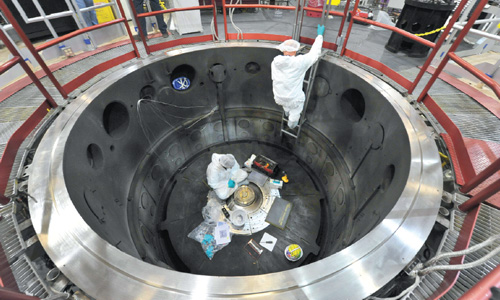
This Article From Issue
March-April 2015
Volume 103, Number 2
Page 87
DOI: 10.1511/2015.113.87
Despite the fact that we see it every day, the Sun remains a mysterious place. Its interior is too opaque for distant instruments to see inside, and too hot for probes to survive. Analysis of the seismic activity in the Sun and other properties gives clues to its inner makeup, but for some time observations haven’t agreed with solar models. To investigate, James Bailey (below), an experimental physicist at Sandia National Laboratories, and his colleagues found a way to re-create conditions deep within the Sun, albeit briefly and on a small scale. Their decade-long experiments show that iron holds part of the answer: That element’s opacity—its ability to hinder propagation of radiation from the solar interior to the outside—is higher than predicted, partially rectifying theories and observations. Bailey discussed his team’s results and their implications with Managing Editor Fenella Saunders.

Photo courtesy of Sandia National Laboratories.
Why didn’t solar theory match up with observations at a certain point?
Around the year 2000 solar physicists were happy because the standard solar model made predictions that agreed with essentially all the observations to a pretty high level of accuracy. But around that time, people ran new analysis techniques on the optical spectra from the Sun. They wound up determining that the abundances of certain elements in the Sun had to be reduced in comparison to what they were thought to be previously, and the reductions were big.
That sent a lot of wheels spinning in the astronomical community because the Sun is used as a yardstick for a lot of astrophysical objects. So when somebody comes along and says there’s 50 percent less oxygen in the Sun, it means essentially there’s 50 percent less oxygen in a lot of other objects throughout the universe.

Image courtesy of NASA.
How does the amount of elements in the Sun relate to its energy?
The energy is generated in the core of the Sun from nuclear reactions, and then that energy has to propagate to the outside. The time scale for the energy to propagate is about a million years, both because the Sun is big, and the radiation has to be absorbed and reemitted over and over again to get to the outside. This process affects the internal structure of the star; it affects the spatial profile of the temperature and the density.
What’s the connection between the abundance of elements and opacity?
The elements that control the radiation transport in the Sun primarily are not completely ionized; they still have some bound electrons. Iron is one of the key players in the opacity. Oxygen is another key player. When people said the amount of oxygen has to be reduced, the opacity that’s contributed by the oxygen will be lower. The same is true of iron, but they didn’t really change the amount of iron. The previous agreement could be restored if the total opacity were higher by about 15 percent. The problem was that the opacities are all based on theoretical models that have never been tested at the conditions that exist inside of a star. That’s where we come in.
How do you mimic the behavior of iron under conditions inside the Sun?
Our facility generates an electrical power that’s many times the total generating capacity of the entire world, for a few billionths of a second. It’s pretty impressive; my building is a few hundred yards away, and I can feel the ground shock when the machine fires. We can heat material up to the temperature and density that exists inside the Sun. The key advance is we can do it with a sample that’s big enough and can be controlled well enough to make very accurate measurements of the material properties, such as the opacity.
What’s a "big enough" sample here?
It’s like a grain of sand. It doesn’t sound very big, but in our field of high energy density physics, we deal with very small samples that last for very short times. Our experiment takes about three billionths of a second, and that’s actually a pretty long experiment for this field.
How were you able to determine the true, higher opacity for iron?
We basically measure the transmission of x-rays through a thin sample of iron mixed with magnesium. We are measuring iron atoms just the way they would be inside the Sun. We measure the opacity as a function of wavelength. We found that there was a serious discrepancy between our data and the models. We spent the last two years checking our results, doing more experiments, doing more analysis, trying to find any possible problem that could be biasing the experimental results. And up to now we still haven’t found anything wrong with it.
Is that why it took you a decade of work to reach that conclusion?
To put that in perspective, it’s been known for 100 years that we should measure these opacities. It’s just a very challenging problem. So the fact that it took us a decade doesn’t make me feel too bad. A lot of physics research today is high-risk research that can take a decade or more to find out where the investigations are going to lead you. It’s just part of life if you’re going to be a scientist; you have to have perseverance.

Image courtesy of Sandia National Laboratories.
Do you feel lucky, then, that you got such a dramatic result?
I would have been just as happy if the result had agreed with the models. It would still have been the very first time that these opacity models had been confirmed at the conditions that exist inside the Sun. But then solar physicists would have had to continue looking for other problems with our understanding of the Sun.
So there is some lingering controversy to your results?
Yes, definitely. Right now we don’t have a theoretical understanding for why iron opacity should be different from the predictions. The opacity goes up and down as a function of the wavelength. I think it will be controversial until we do have a better understanding.

American Scientist Comments and Discussion
To discuss our articles or comment on them, please share them and tag American Scientist on social media platforms. Here are links to our profiles on Twitter, Facebook, and LinkedIn.
If we re-share your post, we will moderate comments/discussion following our comments policy.